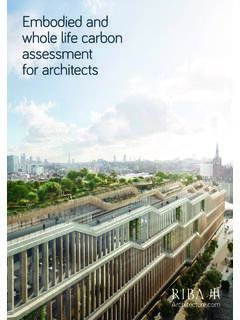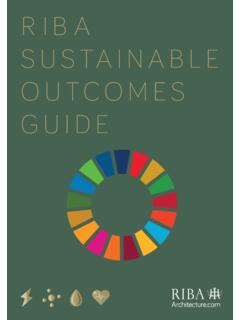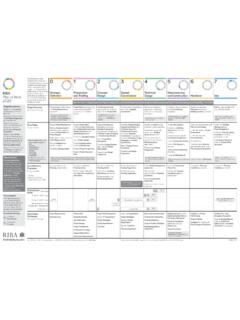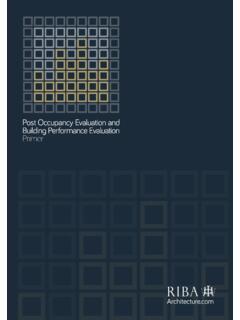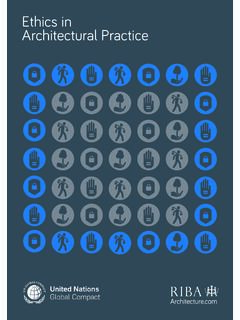Transcription of Climate Challenge - Royal Institute of British Architects
1 R IB A. RIBA 2030 Climate Challenge version 2 (2021) 1. 2030. C L I M AT E. Challenge . V ERSI O N 2 (202 1). Sign up to join the RIBA. 2030 Climate Challenge at RIBA 2030 Climate Challenge version 2 (2021) 2. RIBA 2030 Climate Challenge The RIBA has developed voluntary performance targets for operational energy use, water use and embodied These performance targets form the basis of the 2030 Climate Challenge which the RIBA has been developed in consultation with other professional UK construction bodies. The performance targets align with the future legislative horizon and set out a challenging but achievable trajectory to realise the significant reductions necessary by 2030 in order to have a realistic prospect of achieving net zero carbon for the whole UK building stock by 2050. The RIBA 2030 Climate Challenge does not seek to replace or replicate a building environmental assessment and there is no associated RIBA 2030 Climate Challenge certification procedure.
2 Instead, the RIBA presents a set of performance outcome targets for RIBA Chartered Practices to aim towards. The 2030 Climate Challenge is voluntary and is based on trust, there is no penalty imposed on Practices or projects that fall short of the Challenge . The purpose of the RIBA 2030 Climate Challenge is to encourage Practices to take action now and to collaboratively shift in the profession towards outcome orientated design approaches. Joining the RIBA 2030 Climate Challenge The 2030 Climate Challenge is currently open to all RIBA Chartered Practices. Signatories who join the Challenge commit to attempt to meet the targets on all their new and major refurbishment projects and commit to submitting data on these projects2 to the RIBA, when available. Submitted data will be anonymised and used only for specific purposes as outlined below. Whilst becoming a 2030 Climate Challenge signatory is currently restricted to RIBA. Chartered Practices, the targets themselves are open source and can be used and embedded into projects or even in business plans.
3 There is no penalty or consequence for projects that miss the Challenge 's voluntary performance targets. Equally by joining the Challenge , Practices are not mandated to submit data on each and every single project. 1. Further guidance can be found in the RIBA Sustainable Outcomes Guide (November 2019). 2. The size of new and major' projects will vary between Practices, depending on Practice size, location etc. The RIBA requests that as a minimum, signatories submit data relating to their significant projects; significance' may be reflected in project complexity or cultural value, not necessarily only by project size and cost. RIBA 2030 Climate Challenge version 2 (2021) 3. Take Action Now The Climate emergency demands urgent action and leadership by Architects and the wider construction industry. The last decade (2011-2020) was the warmest on We must act now and play our part in limiting the further exacerbation of Climate change.
4 In 2019 the UK Government passed a law to require the UK to end its contribution to global warming by 2050 by bringing all greenhouse gas emissions to net zero. The built environment sector must do its part to meet this ambition and ensure that new and retrofit buildings deliver net zero whole life carbon in advance of incoming regulation. The 2019 Green Construction Board Buildings Mission 2030 report4 shows that net zero operational carbon is already possible. The Challenge for the profession is to extend good practice to all future work, as highlighted by the World Green Building Council's report on net zero embodied Net zero whole life carbon should be prioritised in lower density areas using on-site renewables. In urban areas net zero whole life carbon will likely require additional offsite renewable energy generation, with certified woodland offsetting6 in the UK as a last resort. Energy demand reduction and energy efficiency must lead all approaches irrespective of geographical location.
5 Buildings designed today should aim for RIBA 2025 targets as a minimum and 2030 targets whenever possible. RIBA 2030 Climate Challenge as built target trajectories The RIBA joined the global declare' movement in June 2019 and to ensure that the strong words of the declaration of a Climate emergency are matched by actions, the RIBA has set RIBA Chartered Practices a Challenge of achieving the following reductions as soon as possible but as a minimum for projects in operation in 2030: 1. Reduce operational energy demand by at least 60% from current business as usual baseline figures, before offsetting 2. Reduce embodied carbon by at least 40% from current business as usual baseline figures, before offsetting 3. Reduce potable water use by at least 40% from CIRIA benchmark/ Building Regulation figures 4. Achieve all core health and wellbeing metrics (set out in the table below). These reductions will also form the basis of RIBA's recommendations to Government for future Building Regulations requirements.
6 3. State of the Global Climate 2020 (WMO-No. 1264), WMO (2021). 4. Buildings Mission 2030: Background Report to Recommendations from the Green Construction Board in response to the 2030 Buildings Mission (2019). 5. World Green Building Council Advancing Net Zero embodied carbon call to action report (2019). 6. Net Zero carbon Buildings: A Framework Definition (2019). RIBA 2030 Climate Challenge version 2 (2021) 4. The Targets v2 (2021). The voluntary operational energy and water use and embodied carbon performance targets that are set out in the 2030 Climate Challenge have been developed by the RIBA consultation with experts across the industry. The targets take into account the latest recommendations from the Green Construction Board7 and are aligned with other built environment professional bodies. Originally launched in October 2019, the RIBA 2030 Climate Challenge has now been re-issued as Version 2 (2021). with refined and updated targets that encompass development in the knowledge base of performance trajectories particularly in the embodied carbon field.
7 The embodied carbon targets in Version 2 are now aligned with LETI, the whole life carbon Network and others, and follow the latest jointly authored guidance. Version 2 of the Climate Challenge presents ambitious but achievable forward-facing performance outcomes, set against business-as-usual compliance approaches. As the targets are for performance outcomes of buildings in operation, the RIBA advocates that buildings in design today should, as a minimum, adopt the 2025 targets. These targets are based on domestic and commercial buildings, the RIBA recognises that there may need to be further refinement by sector and building type in the future. In addition, the targets themselves may need further revision in the coming years as more detailed data and further work in sectoral contributions to carbon emissions in line with science-based targets is undertaken by the industry. The RIBA therefore acknowledges the imperfect nature of the targets but give the urgency for action on carbon emissions, there is no time to wait for the perfect set of figures to be developed.
8 7. Buildings Mission 2030: Background Report to Recommendations from the Green Construction Board in response to the 2030 Buildings Mission (2019). RIBA 2030 Climate Challenge version 2 (2021) 5. RIBA 2030 Climate Challenge target metrics for non-domestic (new build offices). RIBA Sustainable Business as usual Outcome Metrics (new build, compliance approach) 2025 Targets 2030 Targets Notes Operational Energy 130 kWh/m2/y < 75 kWh/m /y 2. < 55 kWh/m /y 2. Targets based on GIA. Figures include DEC B (50) and/or DEC B (40) and/or regulated & unregulated energy kWh/m2/y DEC D (90) consumption irrespective of source (grid/. NABERS Base build 5 NABERS Base build 6 renewables). 1. Use a Fabric First' approach 2. Minimise energy demand. Use efficient services and low carbon heat 3. Maximise onsite renewables embodied carbon 1400 kgCO2e/m2 < 970 kgCO2e/m2 < 750 kgCO2e/m2 Use RICS whole life carbon (modules A1-A5, B1-B5, C1-C4 incl sequestration).
9 KgCO2e/m2 Analysis should include minimum of 95% of cost, include substructure, superstructure, finishes, fixed FF&E, building services and associated refrigerant leakage. 1. whole life carbon Analysis 2. Use circular economy strategies 3. Minimise offsetting & use as last resort. Use accredited, verifiable schemes (see checklist). BAU aligned with LETI band E; 2025. target aligned with LETI band C and 2030 target aligned with LETI band B. Potable Water Use 16 l/p/day < 13 l/p/day < 10 l/p/day CIBSE Guide G. Litres/person/day (CIRA W11 benchmark). RIBA 2030 Climate Challenge target metrics for non-domestic (new build schools). RIBA Sustainable Business as usual Outcome Metrics (new build, compliance approach) 2025 Targets 2030 Targets Notes Operational Energy 130 kWh/m /y 2 < 70 kWh/m2/y < 60 kWh/m2/y Targets based on GIA. Figures include regulated & unregulated energy kWh/m2/y consumption irrespective of source (grid/renewables).
10 Refer to Department for Education Output Specifications for schools: 2025: Primary <55 kWh/m2/y, 2030: Primary <45 kWh/m2/y 1. Use a Fabric First' approach 2. Minimise energy demand. Use efficient services and low carbon heat 3. Maximise onsite renewables embodied carbon 1000 kgCO2e/m2 < 675 kgCO2e/m2 < 540 kgCO2e/m2 Use RICS whole life carbon (modules A1-A5, B1-B5, C1-C4 incl sequestration). kgCO2e/m2 Analysis should include minimum of 95% of cost, include substructure, superstructure, finishes, fixed FF&E, building services and associated refrigerant leakage. 1. whole life carbon Analysis 2. Use circular economy strategies 3. Minimise offsetting & use as last resort. Use accredited, verifiable schemes (see checklist). BAU aligned with LETI band E; 2025. target aligned with LETI band C and 2030 target aligned with LETI band B. Potable Water Use m3/pupil/y < m3/pupil/y < m3/pupil/y Refer to Department for Education Output Specifications for schools.
